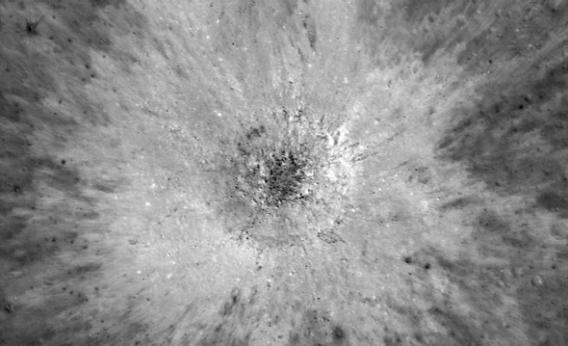Create a free profile to get unlimited access to exclusive videos, sweepstakes, and more!
The Purloined Lunar Crater

The Moon is our inconstant companion; always changing its face, always changing its position in the sky. But to be fair itâs always there, somewhere, and always predictable.
Or is it? While reading up on a small (180 meter, or 200 yard diameter) crater on the Moonâs far side, I got quite a surprise. I bet you will too.
First, hereâs the crater in question:
Lovely, isnât it? The shot was taken by the Lunar Reconnaissance Orbiter when it was directly over the crater. Not only that, the Sun was almost directly overhead. That means there are no shadows, so the crater itself looks soft and difficult to see. The rough surface in the middle is studded with boulders, some as big as cars or small trucks.
The ejecta blanket â the dust and rock thrown out by the blast of the impact â is quite bright and obvious. This means the crater is young; lunar dust darkens over time from the erosive effects of the Sun and micrometeorite impacts. Why, it may only be a few million years old!
That high Sun angle makes the ejecta even more obvious, too, because it highlights brightness changes in the surface. Dust with a higher albedo (the fraction of sunlight it reflects) is easier to spot, and the newer dust is more reflective than the older surface.
But thereâs something else going on here as well. Because there are no shadows, changes in topography â hills and dips â are more difficult to see, hiding some features. Donât believe me? Then check out this next LRO picture taken of the same spot, but when the Sun was at a much lower angle:
Yes, thatâs really the same spot! I scaled and cropped the picture to roughly match the one above; if you look carefully you can match up some smaller craters around the edges. As you can see, thereâs a second crater about the same size as the first one thatâs almost completely hidden in the first picture. Now that you know itâs there, you can see hints of it in the first shot; the ejecta rays (plumes of material that collapsed down into long, linear features) curve when they cross the hidden crater. Other than that, though, youâd be forgiven for saying itâs not there at all. It helps that the crater is clearly (well, in the second picture) much older; the very slow erosion process on the Moon has softened its features; it may be billions of years old.
Amazing. An ancient crater, hidden on the Moon in plain sight. Obviously, if you want to study the Moon, you canât just take a picture and think youâre seeing the whole thing. Itâs critical to wait a while and look again. The Moon may be an inconstant companion, but perhaps thatâs not such a bad thing if you want to learn more about it.
[Note: While poking around for this article, I found one I wrote back in 2006 titled âThe Purloined Craterâ; this was about an impact crater hidden in plain sight⦠on Earth! And not-too-coincidentally, it too was spotted in images taken by an orbiting camera.]


























